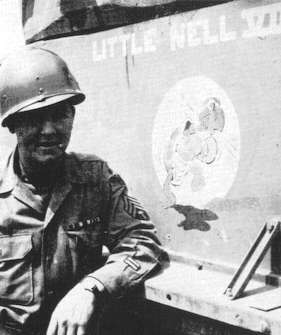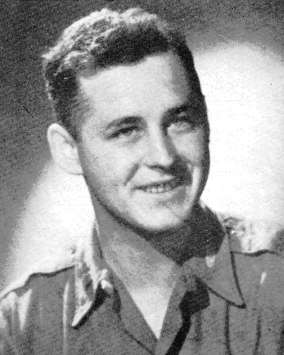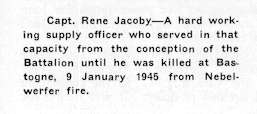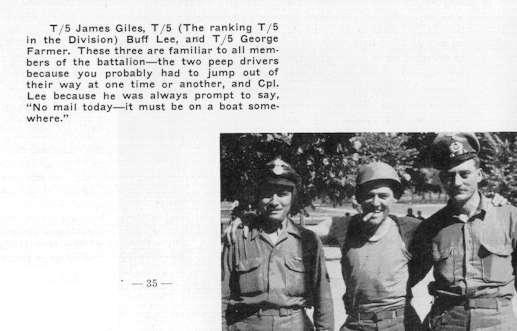Nov - Dec Offensive |
Table of Contents |
Siegfried Line |
Nov - Dec Offensive |
Table of Contents |
Siegfried Line |
Our
stay at Merlebach was a very pleasant one. We enjoyed recreation of every
sort, and had, in our reserve capacity, ample time to catch up on our maintenance
of vehicles, weapons and equipment. But, just when we were beginning to
get very comfortable, things started popping in the northern sector of
the allied line, and Von Rundstedt pulled his famous counter-attack, and
conditions up there began to look pretty serious. We immediately anticipated
that the "Super Sixth" would be called on soon to help put out the fire.
We'd had things too easy lately! Then, and on December 22nd we were alerted
for movement in this direction.
On the following evening, with other elements of' the division, the battalion set out from Merlebach on a night march back to Metz. The move west was smooth and swift, and we closed there at 0600. The troops were billeted in the City, and devoted the rest of the day and evening to celebrating Christmas Eve, most of the time was spent on personal maintenance with special emphasis placed on lubrication!
Merry Christmas! We did manage to have a wonderful holiday dinner and recover, and then we moved out on another night concealed march to Lanningen, Luxembourg. The reason for the last two night marches was, as you can well imagine, because enemy air in support of Von Rundstedt's attack was very active and out in force. But we closed at our assigned destination without mishap at 0600 the following morning, where we remained until the 29th, waiting for further orders. We were still operating under the control of CCA, but when we were ordered to Haberu, Belgium, and closed there at 1730, we came under the control of CCB. Then, just before midnight on the following day, we departed from Haberu enroute to Bastogne, The roads were ice covered and so very dangerous, causing several accidents and changes in routes. Our progress was carefully slow, and at Vaux-LesRosieres, CCA of the 11th Armored Division turned on our route of advance from the east, thus blocking the road and causing us several hours delay.
Previous plans had called for our making an attack north of Bastogne at 0800, but the above-mentioned difficulties held up our approach march to the line of departure in the vicinity of Bizory so that we were ordered into a bivouac with the rest of the combat command in an area south of Sibret. At 2300 we resumed our march to the Bastogne area.
The NEW
YEAR started off with a bang. With the CP closed at Bastogne, and the companies
in an assembly area at the road junction northeast of
Bastogne.
Our attack, after a careful reconnaissance by all troop leaders involved,
jumped off at 0840, and Col. Davall employed the following plan:
Company
"B" 68th, took up direct fire position on the nose of the hill which lay
in the triangle of roads northeast of Bastogne and north of the main east-west
road covering the high ground west of Magaret. Company "A" with a platoon
of tank destroyers swung around through Bizory, and began an envelopment
of the hill overlooking Magaret, covered all the while by "B" Company's
base of fire. When ABLE had secured position on the approach to the hill,
Company "B"
50th AIB moved through our Baker Company's positions to the stream west of Magaret, where the men dismounted from their half-tracks and began the assault of the hill on foot. "A" company was held up for a short while by a mine field in the vicinity of Bizory, but the attack was resumed at 0940. Our initial objective was taken at 1010. The force moved out at 1030 toward Magaret, and at 1145 Company "A" followed by the infantry, entered the town. Our attacking force encountered considerable resistance from enemy small arms, mortar, and artillery fire on the approach to Magaret, but inflicted severe casualties on the foe, and captured 68 prisoners. The town was finally cleaned out and secured by 1400. Then Company "B" swung north of Magaret and pushed up to take the higher ground overlooking Arloncourt. With the CP in Magaret, Company "D" was sent to the northern portion of the task force sector to connect with Task Force Wall; Baker Company pulled back on the line with Company "D," and "A" Company took positions on "B" Company's south flank and tied in with Task Force Kennedy south of us. Thus, this defensive line, running northwest-southeast, north and east of Magaret, was held during the night.
Perhaps it will help bring a better understanding of our situation, if you recall that Von Rundstedt's drive had been hitherto quite successful; it was a highly geared drive, up to now unchecked, that had gained a great momentum and although they had been momentarily stymied at Bastogne, the krauts had spread out on the flanks and were still rolling. The Sixth Armored Division, however, was attacking in the face of all this, and, faced with this tremendous task, was knifing in to check this push firstly, slow it down, probe for weak spots in the enemy's lines, and then started grinding them back. A not too pleasant prospect -- a job that was to go down in our books as one to call on the greatest possible courage, stamina, and bitterest fighting we had ever known! The men of the 68th faced this prospect, knowing full well what it would entail, calmly confident of their ability to defeat the best that Germany could hurl against us again.
So we settled down for the night in Magaret which was still burning in places from the shelling we had subjected it to earlier in the day. Then at two o'clock in the morning, Jerry launched a strong dismounted counter-attack from the direction of Benonchamps along the axis of the Benonchamps-Magaret road. At the same time bombs were dropped in and around the defensive positions by a lone enemy plane, and helped us here by dropping them in the midst of the counter-attackers, When we had frustrated this attempt, the enemy side-slipped to the west, approaching Magaret along the draw and stream bed from the south, The attack was finally stopped at 0400, after some of the krauts bad infiltrated into town and gotten to within 75 yards of the Charlie Peter, This was our first taste of what was to happen time and again in a seemingly endless succession.
Shortly after noon on the 2nd, the attack on Arloncourt was resumed. "A" Company took direct fire position to cover the approach of "B" Company moving from the west, Then, Baker Company assumed firing positions in the draw south and west of Arloncourt, while "B" of the 50th was brought up and screened the woods south of the town. At this point, our attacking force was taken under very heavy anti-tank fire and small arms fire in and around the town. As a consequence, all but one of "B" Company's tanks were knocked out, and the doughs suffered very heavy casualties and were pinned down. The positions became so untenable and exposed that it was necessary to withdraw the force under cover of smoke. Company "B" and the platoon of infantry were pulled back into Magaret, and Col. Davall shortened his defensive line, tying in with TF Kennedy (69th Tk Bn.) who moved up from the south and assumed part of our previous sector.
On the 3rd of January, Task Force Davall maintained its defensive position. The enemy counter-attacked in the morning with tanks and infantry, but was repulsed with many casualties. At that time AT guns, in well concealed and defiladed positions fired on "A" Company's line of tanks, destroying four, and making their position untenable, it was imperative that they be withdrawn. Then at 1500, the task force withdrew in orderly fashion to better defensive positions north and east of Bizory. We must mention the fact here that while it was a necessary move and one to better our position, it was the first time in our experience that we had had to move to the rear due to enemy pressure. It was a bitter pill to swallow -- to yield ground that we had fought so hard to gain, but it had to be. However, every mother's son there vowed to turn the tables with a vicious vengeance as soon as possible!
The Battalion CP withdrew to a point north of Bastogne, and Captain McKenna took command of the forward CP in Bizory. S-3 of the Battalion, indomitable and experienced veteran of all preceding campaigns, Captain McKenna took over the hot spot swiftly and efficiently, and with the aid of Captain Raines, S-2, immediately tied in and stabilized the new line which extended from the road running north from Bizory around the town to the north, thence east connecting with TF Kennedy on the Bizory-Magaret road and about mid-way between the two towns. Task Force Davall also connected in the north and east with TF Wall. By observation during the day and by periodic patrols at night, the line was organized with the Assault Gun Platoon generally in the sector bounded by the roads running north and northeast from Bizory. "B" Company tanks covered the eastern sector, exclusive of both roads with one section in support of the assault gun section in the center, and the others disposed to dominate the high ground from there east to the Magaret road. The TD platoon with four destroyers was placed in support of the line, with a section backing up the center road. Also two infantry platoons and one engineer platoon occupied defensive positions in support of the tanks, while two infantry platoons remained in reserve in town. These were rotated with those on the line. There was no enemy activity during the night except sporadic shelling of the road junction in Bizory (now more aptly termed by the tankers "MISERY").
The 4th
of January saw continued heavy shelling in Bizory which increased to extremely
heavy concentrations about 1700; these concentrations consisted mostly
of accurate artillery and mortar fire and inaccurate nebelwerfer fire.
Then between 2100 and 2200 enemy infantry made a series of short probing
attacks, which were driven off by our braves without loss.

![]()
At about 0300 the next morning, Jerry made a demonstration attack with tanks and infantry, and at 0530 they launched a determined attack with infantry and supported by SP's and tanks. They failed to penetrate our lines! The shelling continued all day long. Then we were assigned a platoon of cavalry reconnaissance which relieved the engineer platoon on the line, and the latter were held in town as reserve. Also Company "A" relieved Company "B" of its sub-sector, and they returned to Task Force reserve northeast of Bastogne.
The strain was becoming terrific, the men were dog-tired, and faces became mask-like, without any feeling at all. While the above was occurring, Bastogne and the surrounding area was subjected to constant shelling by heavy guns, and the town was in a shambles. It will probably never be fully known how desperate our situation was becoming, and it can now be readily imagined what Von Rundstedt's forces could have done, had they been able to break through our position, for we were at the focal point of the whole deal. Had Jerry been able to take Bastogne, he would have secured a traffic artery with an excellent road network to all points. Then he would have shoved his push into high gear again, and there's no telling how far he could have gone, or how much time we would have lost. But he hadn't showed to us any signs of quitting, although all his futile buffetings against our stonewall defense had cost him dearly in manpower, equipment, and time. The sleepless tankers prepared for further attacks!
January 6th brought with it continued shelling, and then at 0400 on the 7th, Jerry launched an infantry attack along the axis of the trail running northeast from Bizory. We held this off but pressure continued until daybreak. Then the attack slipped to the west and a few fanatical enemy entered the town itself. There was some sniper activity in town at about 0900, so our infantry and engineers screened through the town and cleaned them out. There was no let-up in the intermittent heinie artillery fire during the morning, rather it increased to extremely heavy concentrations in the afternoon, raking thoroughly the entire defensive positions. There was present continual tank and artillery pressure and reported contacts from dark to midnight. But the amazing men of the 68th held inexorably.
Again on January 8th, the enemy made a coordinated tank-infantry attack against our right flank and along the axis of the Bizory-Magaret road. Six "A" Company tanks were knocked out like so many clay pigeons, and their fire couldn't effectively find Jerry in his positions along the draw; also the neighboring 69th's fire was long in coming, and ineffectual when it did. The enemy then swung the force of their attack against the hill south of the road and southwest of Magaret. Finally, however, before he could do more damage, Jerry was driven off again by our TD's and artillery fire. We reorganized our positions while the intermittent shellfire continued, and made preparations for an anticipated relief by the 320th Infantry Regiment.
Then, at long last, at 1100 on the 9th, we were relieved of the sector by the 3rd Bn. 320th; at the same time "C" Company was detached from TF Wall and to TF Hannon (320th) in support of an attack southeast of Marvie. The attack jumped off at 1000 and the objective was seized in the afternoon; the tankers remained there through the night in support of the foot-sloggers, while the remainder of the battalion returned to billets in Bastogne. The kitchens were brought up, and a good hot meal awaited the returning warriors, but most of them were so exhausted, so drained of every desire but endless sleep, that they skipped chow and went straight to sleep.
The next day, elements of "D" Company relieved Charlie Company in support of the 35th Division task force, while the rest of the battalion took things easy. Then, on the 11th we moved to the rear to the town of Hompre for further rest and refitting. In spite of the excellent recovery and maintenance job that Captain Halloran's Battalion Maintenance men had done, we had suffered severe losses, and our total strength amounted to little better than a company of tanks. We needed refitting badly. On the following day, Company "D" was relieved from TF Hannon at 1500 and closed in the battalion area at 1700. At this point in the game, while the battle of the bulge raged fiercely, the tables were gradually being turned. Jerry was definitely stopped and our forces on both flanks were putting pincer pressure on the shrinking salient.
We were relieved from CCA and attached to the 320th Infantry Regiment at 2100 on January 14th; Company "B" went to the 3rd battalion, Company "C" to the 1st, and Companies "A" and "D" in reserve. Also, our Assault Guns were to support the 212th Field Artillery Battalion. All set to push the krauts back where they came from. We were to be used from now on as part of tank-infantry, teams that were soon to make Von Rundstedt very sorry that he ever started this bulge business. The attack jumped off at noon, and the woods northeast of Bizory were screened through and cleared, but then we bogged down on the face of heavy tank and automatic weapons fire from the smaller woods to the southwest, so we called the affair to a halt and dug in for the night.
So was
the inauspicious beginning of the new phase in the battle of the bulge,
The siege of Bastogne was, however, definitely over, and we recall that
at that time there burst upon the world a flood of publicity, singling
out for praise the crack 101st Airborne Division and the 4th Armored Division.
The two had done good jobs in the initial stages of the campaign, the former
having stood fast in and around Bastogne before and just after Christmas,
and the latter having broken through to relieve them. But it was disillusioning
and bitter for us, who had come in at the most crucial time and had borne
the brunt of all that highly geared enemy pressure, had thrown back with
heavy losses his every counter-attack, had without sleep or relief fought
him tooth and nail until his terrific drive was sloweddown to a standstill,
to have so conspicuously ignored by the world our courageous stand. We
wondered with no little amazement if this were a war fought by PROs [Web
editor's note: Public Relations Officers], and prepared for the next
move.


On the morning of January 15th, we called for and received an air strike on the small woods that had been so bothersome. Then after the welcome P-47s had worked it over thoroughly by bombing and strafing, the woods was attacked and cleared; this job being accomplished with methodical efficiency on the doughs part, and took them most of the day. On the following day, the task force jumped off at dawn, with the tanks initially in the rear, and cleared the area between the woods and Obourcy. When this was done, "C" Company swiftly moved directly in. This maneuver caught Jerry completely by surprise and the garrison was unable to escape; the remains of an enemy battalion, including the Charlie Oboe and his staff, were consequently mopped up and captured. The tide was turning!
The seventeenth found us continuing the attack; Michamps was taken at 1500 by elements of the 320th Infantry supported by Companies "B" and "C." Also, our Assault Gun Platoon went into position in the vicinity of Bizory and reinforced the fires of the 320th Cannon Company, while at the same time the Mortar Platoon moved into position near Obourcy in support of the 3rd Battalion, 320th Infantry; on the eighteenth the 320th, with our support, held a defensive line along the main road running southeast from Bourcy, tied up some of the loose ends, and prepared to press the advance.
The next day, Company "B," now refitted and reorganized, moved from the rear area in the vicinity of Hompre to Bastogne, and Lt. Colonel Sussman assumed command of the composite force at Michamps. Then, on the following day, elements of "A" Company relieved "C" Company which returned to Bastogne, while all along the line constant pressure was exerted, and our air support was very active, as it became more apparent that Jerry was pulling out and was throwing up his hands at a bad job.
On the 21st, we were relieved from our attachment to TF Byrnes (320th Infantry Regiment) and were attached to Task Force Miltenberger (134th Infantry Regiment), and on the next day Companies "A" and "D" supported the task force's attack on the woods east of Bourcy. At the same time, the Assault Gun and Mortar Platoons remained in position prepared to support the fires of the 212th Armored Field Artillery Battalion. It should be mentioned here, before going further, that we enjoyed working with the infantry. Our mutual cooperation was perfectly harmonious, and their commanders made careful considerate use of our armor; we were not abused, and we were sensibly employed.
The 23rd of January saw Companies "B" and "C" joining "A" and "D" in the vicinity of Bourcy, and on this day we were assigned a novel mission, we didn't have to fight, but rather became temporarily a transport battalion, and chauffered the doughs on our tanks as far as Hofelt, Luxembourg. Then, when the move was accomplished, all companies reverted to battalion control at Hachiville. To clarify this transport business a bit, here is why it was necessary; the ground was snow-blanketed, and so made slogging on foot pretty tough for John Dough. Also Jerry was pulling out as fast as he could, and the infantry couldn't march fast enough dismounted to maintain contact.
Again on the following day, we were called upon to transport Task Force Miltenberger to an assembly area three kilometers northeast of Hachiville. Then, Company "B" supported the 3rd Battalion and Company "C" in the consequent attack on Basbellen, where the enemy had decided to delay. It was hard work for the doughs fighting across snow-covered fields, but the objective was secured by 1800; the remainder of the 68th stayed at Hachiville and Hofelt. On the 25th, Companies "B" and "C" reverted to battalion control and closed in the battalion area at 1145.
All elements of the 68th were assigned the mission, on the 26th, of ferrying troops to task force Miltenberger to the vicinity of Hupperdange and Heinerscheid, "B" Company reconnoitered firing positions northeast of Heinerscheid, and closed in the town prepared to occupy the positions in the event of an enemy counter-attack. All other elements of the battalion, with the exception of Headquarters Company, closed in Hupperdance, and Headquarters Co. closed in bivouac in the vicinity of Asselborn, with the Assault Gun Platoon in position prepared to support artillery fires. The Battle of the Bulge was practically over, for we bad driven Jerry right back to his original line of departure. We were now sitting just west of the German border, and could see from our positions along the Skyline Drive the famous Siegfried Line. The OUR RIVER lay between the krauts and us.
The succeeding five days were luckily uneventful. The Germans entertained no thoughts of attacking; quite the contrary, they were content to hole up in the Siegfried Line pillboxes, lobbed an occasional harrassing round over to our side, and sweated out our next move. We weren't going anywhere ourselves, for we had to pull in the reins, take stock of the situation, get "squared away," and prepare to hurdle a dual barrier, one natural and the other formidably artificial -- the Our River and the Siegfried Line.
On the
last day of the month, Task Force Miltenberger was relieved of the sector
by Task Force Brindle (86th Cavalry Recon Squadron, Mechanized -- our division
reconnaissance). "A" Company was attached to Task Force Brindle, but remained
in its present position. So ended the month of January and the Battle of
the Bulge!

NOTE: Remove question mark from address below when sending email
This page is maintained by Bruce Frederick, EMAIL
.
Last updated: June 12, 1999.